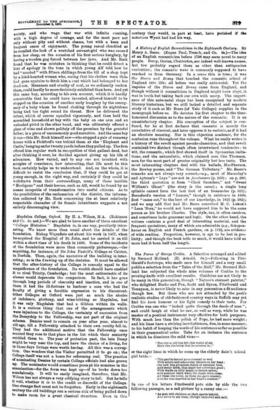A History of English Romanticism in the Eighteenth Century. By
Henry A. Beers. (Regan Paul, Trench, and Co. 9s.)—The idea of an English romanticism before 1798 may seem novel to many people. Percy, Ossian, Chatterton, are indeed well-known names. but few probably regard them as other than antiquarian curiosities; the romantic wave is commonly supposed to have reached us from Germany. In a sense this is true ; it was the Sturm. mind Drang that touched the romantic school of England into life; all before was really ante-natal. Yet the impulse of the Sturm mind Drang came from England, and though without it romanticism in England might have slept, it was in truth but taking back our own with usury. The import- ance of this ante-natal stage has been recognised by modern literary historians, but we still lacked a detailed and separate study of it such as Mr Beers (of Yale College) supplies in the monograph before us. He devotes his first chapter to the time. honoured discussion as to the nature of the romantic. It is an unsatisfactory chapter. His conception of the subject is con- fused, for he at first declares that romantic is merely the correlative of classical, and later opposes it to realistic, as if it had an absolute meaning. Nor is this objection academic, for the confusion runs throughout the volume. What he really writes is a history of the revolt against pseudo-classicism, and that revolt contained two distinct though often intertwined tendencies : to wit, the romantic, which first showed itself in Spenserian imita- tions, and the naturalistic, which claimed men like Thomson, men for the most part of greater originality but less taste. The most interesting chapters deal with the ballads, MacPherson, the Rowley poems, and "The German Tributary." Mr. Beers's remarks are not always very correct, —e.g., most of Macaulay's and Aytoun's " Lays " are not in fourteeners (p. 2C9); on p. 280, the third quotation is from "Clerk Saunders," not "Sweet William's Ghost" (the story is the same) ; a single long syllable cannot form the last foot of an hexameter (p. 311) ; Beresford's version of "Lenore," though in existence in 1800, first "came out," to the best of our knowledge, in 1821 (p. 392); and we may add that had Mr. Beers consulted H. C. Luken's "Lean 'Nora," he would not have supposed him to be the same person as his brother Charles. The style, too, is often careless, and sometimes lacks grammar and logic. On the other hand, the volume contains a good deal of interesting material, and the frequent quotations, many of which are admirable (e.g., Schopen- hauer on English and French gardens, on p. 119), are evidence of wide reading. Proportion, however, is apt to be lost in pro- lixity; and though the book tells us much, it would have told us more had it been half the length.






















































 Previous page
Previous page